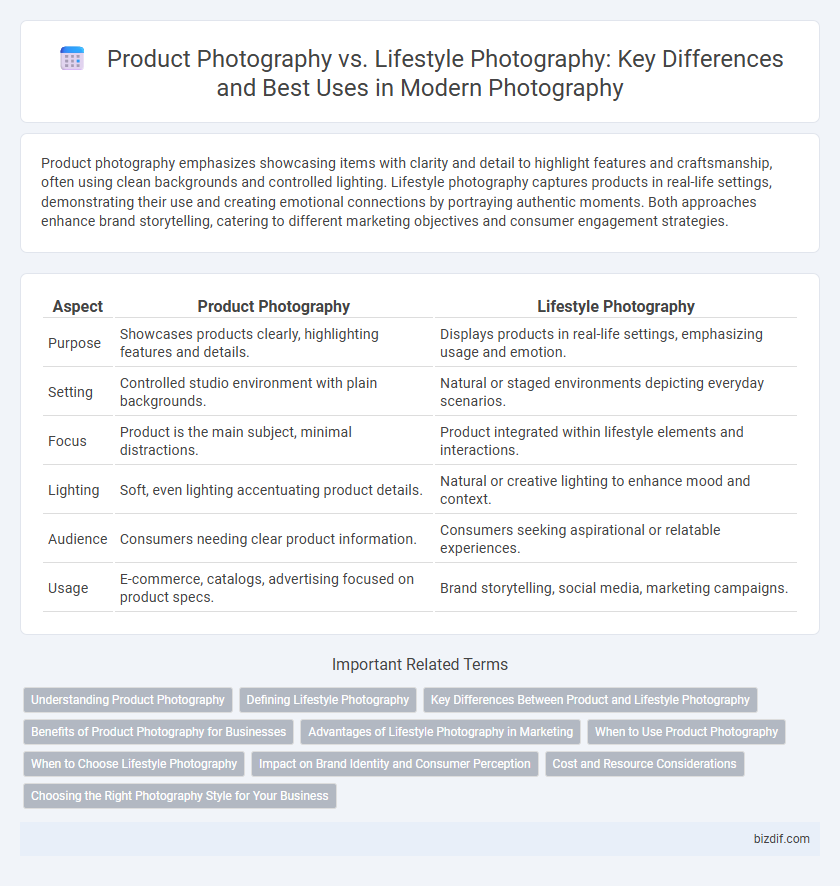Product photography emphasizes showcasing items with clarity and detail to highlight features and craftsmanship, often using clean backgrounds and controlled lighting. Lifestyle photography captures products in real-life settings, demonstrating their use and creating emotional connections by portraying authentic moments. Both approaches enhance brand storytelling, catering to different marketing objectives and consumer engagement strategies.
Table of Comparison
| Aspect | Product Photography | Lifestyle Photography |
|---|---|---|
| Purpose | Showcases products clearly, highlighting features and details. | Displays products in real-life settings, emphasizing usage and emotion. |
| Setting | Controlled studio environment with plain backgrounds. | Natural or staged environments depicting everyday scenarios. |
| Focus | Product is the main subject, minimal distractions. | Product integrated within lifestyle elements and interactions. |
| Lighting | Soft, even lighting accentuating product details. | Natural or creative lighting to enhance mood and context. |
| Audience | Consumers needing clear product information. | Consumers seeking aspirational or relatable experiences. |
| Usage | E-commerce, catalogs, advertising focused on product specs. | Brand storytelling, social media, marketing campaigns. |
Understanding Product Photography
Product photography emphasizes capturing high-quality, detailed images that highlight a product's features, texture, and design to enhance online catalogues and e-commerce platforms. It requires controlled lighting, precise composition, and often a neutral background to ensure the product stands out clearly. Mastery of technical skills such as macro focusing, color accuracy, and post-processing is essential for creating compelling product visuals that drive consumer purchase decisions.
Defining Lifestyle Photography
Lifestyle photography captures real-life moments and emotions to showcase products in authentic, everyday settings, emphasizing how consumers interact with the item naturally. Unlike product photography that highlights the product's design and details against clean backgrounds, lifestyle photography integrates the product within a story or environment to create relatable and compelling visuals. This approach enhances brand connection by evoking feelings and experiences associated with the product's use in daily life.
Key Differences Between Product and Lifestyle Photography
Product photography emphasizes clear, detailed images highlighting the features and quality of the product against clean backgrounds, ideal for e-commerce and catalogs. Lifestyle photography integrates products into real-life settings, showcasing them in use to evoke emotions and context, often used in advertising and social media. The key difference lies in purpose: product photography aims for clarity and information, while lifestyle photography focuses on storytelling and engagement.
Benefits of Product Photography for Businesses
Product photography enhances brand identity by showcasing products with high clarity and detail, attracting potential customers through visually appealing images. It improves conversion rates by providing accurate representations that build trust and reduce purchase hesitation. Businesses benefit from consistent, professional images suited for e-commerce platforms and marketing materials, driving higher sales and customer engagement.
Advantages of Lifestyle Photography in Marketing
Lifestyle photography enhances marketing by creating authentic, relatable images that connect emotionally with target audiences, boosting brand trust and engagement. It showcases products in real-life scenarios, helping consumers visualize usage and benefits, which increases purchase intent. This approach often results in higher conversion rates as customers perceive the brand as genuine and relevant to their daily lives.
When to Use Product Photography
Product photography excels in showcasing items with clear, detailed visuals ideal for e-commerce platforms, catalogs, and advertising campaigns where the focus is on the product itself. It is best used when the goal is to highlight features, colors, and textures without distractions, ensuring potential buyers can evaluate the product accurately. This style is crucial for industries like fashion, electronics, and cosmetics where precise representation influences purchasing decisions.
When to Choose Lifestyle Photography
Lifestyle photography is ideal when brands aim to create an emotional connection by showcasing products in real-life scenarios that highlight their practical use and appeal. It's particularly effective for marketing fashion, home goods, and tech products where context enhances consumer relatability and engagement. Opt for lifestyle photography when the goal is to tell a story that resonates with your target audience, fostering brand authenticity and trust.
Impact on Brand Identity and Consumer Perception
Product photography emphasizes clear, detailed visuals that highlight the features and quality of merchandise, reinforcing a brand's professionalism and reliability. Lifestyle photography integrates products into real-life scenarios, creating emotional connections and portraying the brand as relatable and aspirational. Both styles influence consumer perception by shaping brand identity through distinct visual narratives tailored to specific marketing goals.
Cost and Resource Considerations
Product photography typically requires controlled studio environments, specialized lighting, and props, resulting in higher upfront costs and more extensive resource allocation. Lifestyle photography often involves on-location shoots with natural settings and models, which can reduce studio expenses but increase logistical planning and talent fees. Balancing budget constraints and the intended brand message helps determine the optimal investment in either product or lifestyle photography.
Choosing the Right Photography Style for Your Business
Product photography emphasizes clear, detailed images showcasing the features and quality of your products to boost conversion rates and attract ecommerce shoppers. Lifestyle photography captures products in real-life environments, creating emotional connections by demonstrating use and context, enhancing brand storytelling and customer engagement. Selecting the right photography style hinges on your business goals, target audience preferences, and the platform where the images will be displayed.
Product Photography vs Lifestyle Photography Infographic

 bizdif.com
bizdif.com